
Västerlånggatan
Encyclopedia
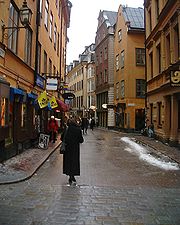
Street
A street is a paved public thoroughfare in a built environment. It is a public parcel of land adjoining buildings in an urban context, on which people may freely assemble, interact, and move about. A street can be as simple as a level patch of dirt, but is more often paved with a hard, durable...
in Gamla stan
Gamla stan
Gamla stan , until 1980 officially Staden mellan broarna , is the old town of Stockholm, Sweden. Gamla stan consists primarily of the island Stadsholmen. The surrounding islets Riddarholmen, Helgeandsholmen, and Strömsborg are officially part of, but not colloquially included in, Gamla stan...
, the old town of Stockholm
Stockholm
Stockholm is the capital and the largest city of Sweden and constitutes the most populated urban area in Scandinavia. Stockholm is the most populous city in Sweden, with a population of 851,155 in the municipality , 1.37 million in the urban area , and around 2.1 million in the metropolitan area...
, Sweden
Sweden
Sweden , officially the Kingdom of Sweden , is a Nordic country on the Scandinavian Peninsula in Northern Europe. Sweden borders with Norway and Finland and is connected to Denmark by a bridge-tunnel across the Öresund....
. Stretching southward between the squares Mynttorget
Mynttorget
Mynttorget is a public square in Gamla stan, the old town in central Stockholm, Sweden.- Setting :From the square the bridge Stallbron leads over to the Parliament island Helgeandsholmen; to the west the street Myntgatan leads to Riddarhustorget, while the quay Kanslikajen stretches along the...
and Järntorget
Järntorget (Stockholm)
Järntorget is a small public square in Gamla stan, the old town in central Stockholm, Sweden. Located in the southernmost corner of the old town, the square connects the thoroughfares Västerlånggatan and Österlånggatan, while the two alleys, Södra Bankogränd and Norra Bankogränd, stretches east...
, it follows the course of the city's now demolished 13th century defensive wall.
The blocks along the street are elongated but only a few metres in width; those on the eastern side oriented lengthwise, and those on the western crosswise. Only four blocks thus forms the eastern side of the street while some 20 are lined-up along the western side. Most of the front doors of the buildings are located either on the quite Prästgatan
Prästgatan
Prästgatan is a street in Gamla stan, the old town in central Stockholm, Sweden, stretching from a cul-de-sac west of the Royal Palace to the street Österlånggatan in the southern corner of the old town. Prästgatan forms a parallel street to Västerlånggatan, Trångsund, Skomakargatan, and...
, the parallel street passing along the eastern side, or in one of the numerous alleys on the street's western side. The intact façades of the northernmost blocks are hiding the semi-detached offices of the Parliament
Parliament of Sweden
The Riksdag is the national legislative assembly of Sweden. The riksdag is a unicameral assembly with 349 members , who are elected on a proportional basis to serve fixed terms of four years...
. To the south of those are the remaining numerous and very narrow blocks and alleys which before the great fire of 1625 occupied the entire western side of the street.
Origin of the name
Today renowned as one of Gamla stan's most picturesque and busy tourist magnets, Västerlånggatan was for many centuries one of the major streets of Stockholm together with ÖsterlånggatanÖsterlånggatan
Österlånggatan is a street in Gamla stan, the old town of Stockholm, Sweden. Stretching southward from Slottsbacken to Järntorget, it forms a parallel street to Baggensgatan and Skeppsbron...
, both of which were running outside of the city walls. During the 15th century, they were both called Allmänningsgatan ("The Common Street") or Långa gatan ("The long street"), occasionally in combination, like Allmenninx longe gathen or longe Almenninx gathen in 1514, and/or with a suffix such as västan till ("to the west") appended. The current name was officially established in 1885.
History
Originally the street was little more than a pathway passing just outside the city's western wall and following the shoreline, as the gently meandering street still reminds us. It was however connecting the northern city gate, Norrbro, with the southern, Söderbro, and it was thus the main route between UpplandUppland
Uppland is a historical province or landskap on the eastern coast of Sweden, just north of Stockholm, the capital. It borders Södermanland, Västmanland and Gästrikland. It is also bounded by lake Mälaren and the Baltic sea...
, the province north of the city, and Södermanland
Södermanland
', sometimes referred to under its Latin form Sudermannia or Sudermania, is a historical province or landskap on the south eastern coast of Sweden. It borders Östergötland, Närke, Västmanland and Uppland. It is also bounded by lake Mälaren and the Baltic sea.In Swedish, the province name is...
, south of the city.
During the 15th century, the street became the paved artery road it still is today, line-up with dwellings and shops on either side. During the Middle Ages and Vasa era
Early Vasa era
The Early Vasa era is a period that in Swedish history lasted between 1523–1611. It began with the reconquest of Stockholm by Gustav Vasa and his men from the Danes in 1523, and Sweden's consequent abandonment of the Kalmar Union, and continued with the reign of Gustav's sons Eric XIV, John...
, the southern part of the street formed part of the district centred on Järntorget
Järntorget (Stockholm)
Järntorget is a small public square in Gamla stan, the old town in central Stockholm, Sweden. Located in the southernmost corner of the old town, the square connects the thoroughfares Västerlånggatan and Österlånggatan, while the two alleys, Södra Bankogränd and Norra Bankogränd, stretches east...
, at the time the most prominent quarters in the city inhabited by influential merchants such as Mårten Trotzig, Mårten Leuhusen and Erik Larsson von der Linde. Along the rest of the street craftsmen had their small workshops, and the northernmost section, stretching between Mynttorget
Mynttorget
Mynttorget is a public square in Gamla stan, the old town in central Stockholm, Sweden.- Setting :From the square the bridge Stallbron leads over to the Parliament island Helgeandsholmen; to the west the street Myntgatan leads to Riddarhustorget, while the quay Kanslikajen stretches along the...
and Storkyrkobrinken
Storkyrkobrinken
Storkyrkobrinken is a street in Gamla stan, the old town in central Stockholm, Sweden.Leading from Högvaktsterrassen near the Royal Palace down to Myntgatan and Riddarhustorget it forms a parallel street to Salviigränd and Stora Gråmunkegränd and is crossed by Trångsund, Prästgatan, and...
, was called Stadssmedjegatan ("City's Smith's Street"), because the blacksmith
Blacksmith
A blacksmith is a person who creates objects from wrought iron or steel by forging the metal; that is, by using tools to hammer, bend, and cut...
s who were confined outside the city because of the danger of fire had their headquarters there. During the 17h century this section was instead inhabited by goldsmiths and accordingly climbed the ranks.
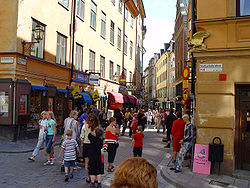
Riksbron
Riksbron is an arch bridge in central Stockholm, Sweden leading from Drottninggatan on Norrmalm 44 metres over to Riksgatan on Helgeandsholmen....
in 1907, and the shops along the street were updated. The medieval street façades were transformed in accordance to the taste of the day; plaster ornaments and cast iron colonettes mail-ordered from Germany replaced the medieval fronts, resulting in the present large shop windows usually displaying the well-preserved interiors from the later part of that century while concealing the often still intact medieval cores of the buildings.
Many of the boutiques founded during the 19th and early 20th century, were still around until the late 1970s; the northern section packed with hotels, while the remaining street was renowned for its milliner's shops including up to 30 coat shops. During the later half of the 20th century however, the scene started to change, increasing rents forcing many old shops to shut down or relocate, the oldest after more than 250 years in business, subsequently replaced by more or less fitting successors marketing tourist-oriented gewgaws.
Notwithstanding, Swedes and tourists alike still love to mingle among the boutiques, the medieval gables and the later additions, the street thus preserving its old ways — still offering its musicians to Stockholmers hurrying to work in the morning; blustering pub-crawlers still vexing stoic dwellers, and the old forged iron signs continuing to ignore the neon signs still tempting passers-by with all sorts of gadgets. Gone are, however, the filth, funeral processions, and prostitution in the area brilliantly described by the troubadour Carl Michael Bellman
Carl Michael Bellman
was a Swedish poet and composer. Bellman is a central figure in the Swedish song tradition and remains a very important influence in Swedish music, as well as in Scandinavian literature in general, to this day....
.
Mynttorget-Storkyrkobrinken

Salviigränd
Salviigränd
Salviigränd is an alley in Gamla stan, the old town in central Stockholm, Sweden. Stretching from Västerlånggatan to Myntgatan, it is the northern-most alley of the former street....
, named after Johan Adler Salvius
Johan Adler Salvius
Johan Adler Salvius was a Swedish baron of Örneholm, chancellor, confidant and representative of the Christina, Queen of Sweden at the peace negotiations at Osnabrück and responsible for the Peace of Westphalia...
(1590-1652), the Swedish main negotiator during the Peace of Westphalia
Peace of Westphalia
The Peace of Westphalia was a series of peace treaties signed between May and October of 1648 in Osnabrück and Münster. These treaties ended the Thirty Years' War in the Holy Roman Empire, and the Eighty Years' War between Spain and the Dutch Republic, with Spain formally recognizing the...
in 1648, used to stretch down to the water. On the left corner (Number 1) is a suite of rooms featuring a neoclassical interior from 1795 restored to its original state, sumptuously furnished and richly decorated with friezes and medallions.
On Number 6 was until recently the bookstore Hemlins bokhandel. It was founded in 1864 and taken over by Emil Hemlin in the 1880s. From the late 18th century and well into modern times, the neighbourhood used to be the quarters of the 'printed word', the part of the city where both the books and their consumers were located, and were people from other parts of the country would come to find and talk about the latest novels.
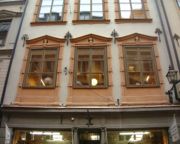
Giuseppe Garibaldi
Giuseppe Garibaldi was an Italian military and political figure. In his twenties, he joined the Carbonari Italian patriot revolutionaries, and fled Italy after a failed insurrection. Garibaldi took part in the War of the Farrapos and the Uruguayan Civil War leading the Italian Legion, and...
and Cavour, obviously added by someone favourably disposed towards the Italian unification
Italian unification
Italian unification was the political and social movement that agglomerated different states of the Italian peninsula into the single state of Italy in the 19th century...
. The entire block is hiding the northern end of Prästgatan
Prästgatan
Prästgatan is a street in Gamla stan, the old town in central Stockholm, Sweden, stretching from a cul-de-sac west of the Royal Palace to the street Österlånggatan in the southern corner of the old town. Prästgatan forms a parallel street to Västerlånggatan, Trångsund, Skomakargatan, and...
, one of the few blind ends of the old town, which was historically known as Helvetesgränd ("Alley of Hell"), either because the city executioner resided in the area or because the entire neighbourhood is located north of the cathedral (e.g. in Norse folklore
Norse mythology
Norse mythology, a subset of Germanic mythology, is the overall term for the myths, legends and beliefs about supernatural beings of Norse pagans. It flourished prior to the Christianization of Scandinavia, during the Early Middle Ages, and passed into Nordic folklore, with some aspects surviving...
associated with the "Kingdom of the Dead").
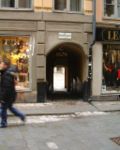 |
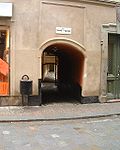 |
On the opposite side, Number 8-14, is another block occupied by the offices of the Parliament. The intact front hide the semi-detached interior where a few clerks are sitting next to fresco
Fresco
Fresco is any of several related mural painting types, executed on plaster on walls or ceilings. The word fresco comes from the Greek word affresca which derives from the Latin word for "fresh". Frescoes first developed in the ancient world and continued to be popular through the Renaissance...
paintings from the 16th and 17th centuries and sculpted beams featuring animals. The three small vaults and their respective street signs — Klockgjutargränd
Klockgjutargränd
Klockgjutargränd is a small alley in Gamla stan, the old town in central Stockholm, Sweden. Passing under a low vault, it connects the street Västerlånggatan to the public square and courtyard Brantingtorget, forming a parallel street to Salviigränd and Kolmätargränd.Mentioned as Klåchgiuatre...
, Kolmätargränd
Kolmätargränd
Kolmätargränd is a small alley in Gamla stan, the old town in central Stockholm, Sweden. Passing under a low vault it connects the street Västerlånggatan to the square and courtyard Brantingtorget forming a parallel street to Klockgjutargränd and Stenbastugränd.Mentioned as Kholmetare Grenden in...
, Stenbastugränd
Stenbastugränd
Stenbastugränd is a small alley in Gamla stan, the old town in central Stockholm, Sweden. Connecting Västerlånggatan to the square Brantingtorget, it forms a parallel street to Kolmätargränd and Storkyrkobrinken....
— gives a hint of what the neighbourhood use to be before WW2 when the circular courtyard, Brantingtorget
Brantingtorget
Brantingtorget is the courtyard of the so called Kanslihusannexet , acting as one of the public squares in Gamla stan, the old town in central Stockholm, Sweden....
, was created and the three alleys stretched much further west.
Just east of the crossing between Storkyrkobrinken
Storkyrkobrinken
Storkyrkobrinken is a street in Gamla stan, the old town in central Stockholm, Sweden.Leading from Högvaktsterrassen near the Royal Palace down to Myntgatan and Riddarhustorget it forms a parallel street to Salviigränd and Stora Gråmunkegränd and is crossed by Trångsund, Prästgatan, and...
and Västerlånggatan, the main northern city gate used to stand during the Middle Ages. At the time a narrow alley, the street was widened during the 1650s in order to create a more stately connection between the Royal Palace and the palaces on Riddarholmen
Riddarholmen
Riddarholmen is a small islet in central Stockholm, Sweden. The island forms part of Gamla Stan, the old town, and houses a number of private palaces dating from the 17th century...
.
Storkyrkobrinken-Kåkbrinken

The café Gråmunken on Number 18 is a well-established café, since several generations renowned for the medieval vaults in the basement. While a gravel ridge composes most of the soil in the surrounding area, the block behind the café is built on solid rock located above sea level during the Viking Age
Viking Age
Viking Age is the term for the period in European history, especially Northern European and Scandinavian history, spanning the late 8th to 11th centuries. Scandinavian Vikings explored Europe by its oceans and rivers through trade and warfare. The Vikings also reached Iceland, Greenland,...
, and hopefully future excavations will be able to further document the earliest history of the area. Archaeological excavations in the street just outside Number 18 have unveiled several layers of earlier street levels, with traces of paved streets found a metre below the present pavement. North of Number 18 is Stora Gråmunkegränd
Stora Gråmunkegränd
Stora Gråmunkegränd is an alley in Gamla stan, the old town in central Stockholm, Sweden. Stretching west from Västerlånggatan down to Munkbron and Munkbroleden, it is crossed by Stora Nygatan, and forms a parallel street to Storkyrkobrinken and Helga Lekamens Gränd.The alley is named after the...
("Great Grayfriars Alley"), which used to lead from the Greyfriars islet (Riddarholmen
Riddarholmen
Riddarholmen is a small islet in central Stockholm, Sweden. The island forms part of Gamla Stan, the old town, and houses a number of private palaces dating from the 17th century...
) to the defensive tower on the east side of Västerlånggatan. South of the café is Helga Lekamens Gränd
Helga Lekamens Gränd
Helga Lekamens Gränd is an alley in Gamla stan, the old town in central Stockholm, Sweden. Connecting Västerlånggatan to Stora Nygatan, it forms a parallel street to Stora Gråmunkegränd and Göran Hälsinges Gränd....
("Alley of the Holy Body [of Christ]"), named after an influential guild existent from the 15th century to the Reformation (1520s). Between these two alleys is a barred alley.
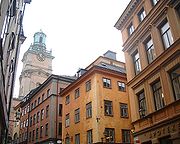
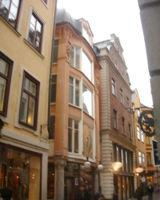
Art Nouveau
Art Nouveau is an international philosophy and style of art, architecture and applied art—especially the decorative arts—that were most popular during 1890–1910. The name "Art Nouveau" is French for "new art"...
glazed façade on Number 22 is from 1907 and the building, slightly less than five metres wide, is arguably the narrowest hotel in town. However inviting, the building safeguards stories of both local and national heroes: During the 18th century a number of taverns succeeded each others on the address, one of which was the "Deft & Done" (Flink & Färdig), named after the inscription on one of the emergency coins of King Charles XII
Charles XII of Sweden
Charles XII also Carl of Sweden, , Latinized to Carolus Rex, Turkish: Demirbaş Şarl, also known as Charles the Habitué was the King of the Swedish Empire from 1697 to 1718...
, and owned a by Catharina Burman, a woman renowned for "intoxication, oaths, scolding, and curses". A hundred years prior to this two printers resided in the block; one was Arnold Helsing, the other his journeyman Ignatius Meuer, who immigrated to Stockholm from Thuringia
Thuringia
The Free State of Thuringia is a state of Germany, located in the central part of the country.It has an area of and 2.29 million inhabitants, making it the sixth smallest by area and the fifth smallest by population of Germany's sixteen states....
, Germany, in 1610 and 21 years old took over the printing house. Before Ignatius died 83 years old, the nine presses in his workshop had produced the Ordinari Post-Tijdender, the oldest newspaper in the world, and the Bible of Charles X
Charles X Gustav of Sweden
Charles X Gustav also Carl Gustav, was King of Sweden from 1654 until his death. He was the son of John Casimir, Count Palatine of Zweibrücken-Kleeburg and Catherine of Sweden. After his father's death he also succeeded him as Pfalzgraf. He was married to Hedwig Eleonora of Holstein-Gottorp, who...
in Swedish. Ignatius and the son of the former printer eventually gave their names to the two alley flanking the hotel: Ignatiigränd
Ignatiigränd
Ignatiigränd is an alley in Gamla stan, the old town in central Stockholm, Sweden. Stretching from Västerlånggatan to Stora Nygatan, it forms a parallel street to Göran Hälsinges Gränd and Gåsgränd....
and Göran Hälsinges Gränd
Göran Hälsinges Gränd
Göran Hälsinges Gränd is an alley in Gamla stan, the old town in central Stockholm, Sweden. Connecting Västerlånggatan to Stora Nygatan, it forms a parallel street to Helga Lekamens Gränd and Ignatiigränd....
, the latter is otherwise mostly remembered through the lyrics of the troubadour Carl Michael Bellman
Carl Michael Bellman
was a Swedish poet and composer. Bellman is a central figure in the Swedish song tradition and remains a very important influence in Swedish music, as well as in Scandinavian literature in general, to this day....
who describes the alley as renowned for its prostitutes.
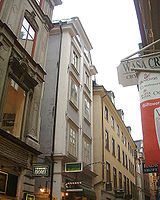
Rococo
Rococo , also referred to as "Late Baroque", is an 18th-century style which developed as Baroque artists gave up their symmetry and became increasingly ornate, florid, and playful...
-style marten
Marten
The martens constitute the genus Martes within the subfamily Mustelinae, in family Mustelidae.-Description:Martens are slender, agile animals, adapted to living in taigas, and are found in coniferous and northern deciduous forests across the northern hemisphere. They have bushy tails, and large...
s added to the medieval building by the furrier Nikolaus Björk in the 1740s, but that's another story. The alley passing through the building, Gåsgränd
Gåsgränd
Gåsgränd is an alley in Gamla stan, the old town in central Stockholm, Sweden. Connecting the streets Västerlånggatan, Stora Nygatan, and Lilla Nygatan, it forms a parallel street to Ignatiigränd and Överskärargränd, and leads down to the square Munkbron on the western waterfront of the old town...
, and the one south of it, Överskärargränd
Överskärargränd
Överskärargränd is an alley in Gamla stan, the old town in central Stockholm, Sweden...
, both lead to Gåstorget
Gåstorget
Gåstorget is a small public square in Gamla stan, the old town in central Stockholm, Sweden, situated between the two alleys Överskärargränd and Gåsgränd....
, one of the smallest squares in Stockholm.
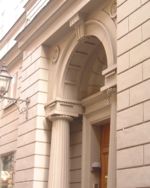
Erik Palmstedt
Erik Palmstedt was an outstanding Swedish architect working for the court circle of Gustav III, where he was in the forefront of Neoclassical style and at the heart of a social and intellectual circle that formed round him...
, the great architect of the closing 18th century. Designed in 1801, but still uncompleted by the time for his death two years later, the façade reflects the architect's late reduced style, lighter than the Custom House at Skeppsbron
Skeppsbron
Skeppsbron is both a street and a quay in Gamla stan, the old town of Stockholm, capital of Sweden, stretching from the bridge Strömbron in front of the Royal Palace southward to Slussen....
but tighter than the Stock Exchange
Stockholm Stock Exchange
The Stockholm Stock Exchange is a stock exchange located in Stockholm, Sweden. Founded in 1863 it is the primary securities exchange of the Nordic Countries....
at Stortorget. Still preserved are the cast iron columns and the archivolt
Archivolt
An archivolt is an ornamental molding or band following the curve on the underside of an arch. It is composed of bands of ornamental moldings surrounding an arched opening, corresponding to the architrave in the case of a rectangular opening...
of the portico, and the pilaster
Pilaster
A pilaster is a slightly-projecting column built into or applied to the face of a wall. Most commonly flattened or rectangular in form, pilasters can also take a half-round form or the shape of any type of column, including tortile....
s and vaults
Vault (architecture)
A Vault is an architectural term for an arched form used to provide a space with a ceiling or roof. The parts of a vault exert lateral thrust that require a counter resistance. When vaults are built underground, the ground gives all the resistance required...
of the entrance and staircase. On the right side is a boundary plate displaying the coat of arms of the provinces Uppland
Uppland
Uppland is a historical province or landskap on the eastern coast of Sweden, just north of Stockholm, the capital. It borders Södermanland, Västmanland and Gästrikland. It is also bounded by lake Mälaren and the Baltic sea...
and Södermanland
Södermanland
', sometimes referred to under its Latin form Sudermannia or Sudermania, is a historical province or landskap on the south eastern coast of Sweden. It borders Östergötland, Närke, Västmanland and Uppland. It is also bounded by lake Mälaren and the Baltic sea.In Swedish, the province name is...
, the message of which, UPLANDz och SUDERMANNALANDz SKILLNAD ("Uppland's and Södermanland's difference"), is often misinterpreted as indicating the delimitation of the two provinces, but is only informing of an old border between two historical diocese
Diocese
A diocese is the district or see under the supervision of a bishop. It is divided into parishes.An archdiocese is more significant than a diocese. An archdiocese is presided over by an archbishop whose see may have or had importance due to size or historical significance...
s.
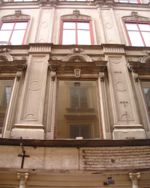
Jöran Persson
Jöran Persson, alternatively Göran Persson , was King Eric XIV of Sweden's favorite, most trusted, counsellor and head of the King's network of spies. He was widely seen as a Machiavellian figure, and of holding too much influence over Eric...
(1530-1568), the Machiavellian
Machiavellianism
Machiavellianism is, according to the Oxford English Dictionary, "the employment of cunning and duplicity in statecraft or in general conduct", deriving from the Italian Renaissance diplomat and writer Niccolò Machiavelli, who wrote Il Principe and other works...
advisor of King Eric XIV
Eric XIV of Sweden
-Family and descendants:Eric XIV had several relationships before his marriage. With Agda Persdotter he had four daughters:#Margareta Eriksdotter , married 1592 to Olov Simonsson, vicar of Horn....
, who used his influence well and owned a series of buildings in the city, including Number 30. He was removed and his estates confiscated following the death of the king. On either side of the building are the alleys Sven Vintappares Gränd
Sven Vintappares Gränd
Sven Vintappares Gränd is a small alley in Gamla stan, the old town of Stockholm, Sweden. Stretching from Västerlånggatan to Stora Nygatan, it forms a parallel street to Överskärargränd and Didrik Ficks Gränd, while passing on the north side of the small square Sven Vintappares Torg.First...
and Didrik Ficks Gränd
Didrik Ficks Gränd
Didrik Ficks Gränd is an alley in Gamla stan, the old town of Stockholm, Sweden. Stretching from Västerlånggatan to Stora Nygatan, it forms a parallel street to Sven Vintappares Gränd and Yxsmedsgränd while passing on the south side of the small square Sven Vintappares Torg.Mentioned as Dirich...
, the former named after the wine-taper of the king and the latter named after a German tenant, Didrich Fischer, in a property owned by the son of Jöran Persson, Erik Jöransson Tegel.
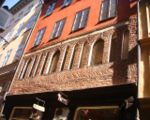
On Number 37 was the home of Olof Palme
Olof Palme
Sven Olof Joachim Palme was a Swedish politician. A long-time protegé of Prime Minister Tage Erlander, Palme led the Swedish Social Democratic Party from 1969 to his assassination, and was a two-term Prime Minister of Sweden, heading a Privy Council Government from 1969 to 1976 and a cabinet...
, former PM assassinated in 1986, and unconfirmed reports have it his murderer was seen lurking in the street shortly before the assassination. On the opposite side is the vault leading to Yxsmedsgränd
Yxsmedsgränd
Yxsmedsgränd is an alley in Gamla stan, the old town in central Stockholm, Sweden.Stretching south from Västerlånggatan to Stora Nygatan, it forms a parallel street to Didrik Ficks Gränd and Kåkbrinken and is crossed by Lilla Nygatan and Munkbrogatan.Throughout its history it appears under various...
, a name literally meaning "Axe Blacksmith's Alley" but probably a corruption of the name Yskeme owned by a man living in the alley and possibly of Estonian or Finnish origin.
Kåkbrinken-Tyska Brinken
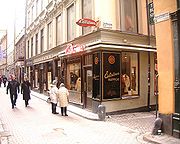
On the address was the milliner's shop of Carolina Lindström, founded in 1842 and during many years the oldest in town. She was arguably one of the most enterprising women in the city, the habit of working late at night giving her the nick "The Evening Star" and, in 1844, she became rich as she got to know about the death of King Charles XIV before her competitors and bought all the crape
Crape
Crape is a silk, wool, or polyester fabric of a gauzy texture, having a peculiar crisp or crimpy appearance....
s and other mourning clothes in the city. She even survived her husband, a gambling spice trader who nearly bankrupted the family, and pursued her business for 50 years until her death.
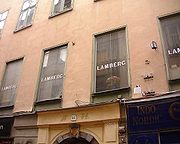
Westphalia
Westphalia is a region in Germany, centred on the cities of Arnsberg, Bielefeld, Dortmund, Minden and Münster.Westphalia is roughly the region between the rivers Rhine and Weser, located north and south of the Ruhr River. No exact definition of borders can be given, because the name "Westphalia"...
in 1620, lived on Number 44, just as did his son and namesake who was raised to peerage and appointed county governor, and for several centuries the building continued to be leavened by the smells of liquor. The milliner's shop Lamberg, founded in 1877 by the then 21 years old Augusta Lamberg from Gothenburg
Gothenburg
Gothenburg is the second-largest city in Sweden and the fifth-largest in the Nordic countries. Situated on the west coast of Sweden, the city proper has a population of 519,399, with 549,839 in the urban area and total of 937,015 inhabitants in the metropolitan area...
, was located over the punch manufacture of J G Grönstedt in the basement, and, as the story goes, the vapours from the latter attracted customers to the former. The building was redesigned in the 18th century in the Rococo
Rococo
Rococo , also referred to as "Late Baroque", is an 18th-century style which developed as Baroque artists gave up their symmetry and became increasingly ornate, florid, and playful...
manners of J W Dinling, the rounded corners of which are still found in the courtyard and on the first floor.

For more than a hundred years, the glove factory of Carl Malmberg, founded in 1877, was located on this address, as a royal purveyor delivering the kid gloves required at the balls at the Royal Palace.
In what was the southern building, the wine dealer Mårten Hartman opened the tavern Källaren Rostock
Rostock
Rostock -Early history:In the 11th century Polabian Slavs founded a settlement at the Warnow river called Roztoc ; the name Rostock is derived from that designation. The Danish king Valdemar I set the town aflame in 1161.Afterwards the place was settled by German traders...
in 1643, an establishment much later featuring in the 45th epistle of Carl Michael Bellman
Carl Michael Bellman
was a Swedish poet and composer. Bellman is a central figure in the Swedish song tradition and remains a very important influence in Swedish music, as well as in Scandinavian literature in general, to this day....
. It retells the story of how Corporal Mollberg while attending the tavern got into trouble for playing the reel
Reel
A reel is an object around which lengths of another material are wound for storage. Generally a reel has a cylindrical core and walls on the sides to retain the material wound around the core...
(called polska in Swedish, e.g. "a polish") of the Queen of Poland, and thus stirred up the temper of the gentlemen around him because of the disputed partition of Poland.
| Tjänare, Mollberg, hur är det fatt? | Howdy, Mollberg, what's up? |
| Var är din harpa, var är din hatt? | Where is your harp, where is your hat? |
| Ack, hur din läpp är kluven och stor! | Oh, how you lip is split and puffed! |
| Var har du varit? Svara, min bror! | Where have you been? Answer, my brother! |
| Till Rostock, min far, | To Rostock, old man, |
| Min harpa jag bar. | My harp I bore. |
| Där börjades krakel | There begun a brawl |
| om mig och mitt spel | about me and my play |
| och bäst jag spelte — pling plingeli plång | and whilst I played — tinkle tinkely tang |
| kom en skoflickare, hjulbent och lång | came a shoe patcher, bow-legged and long |
| högg mig på truten. .. Pling plingeli plång! | blew me on the chaps. .. Tinkle tinkery tang! |
| [...] | [...] |
| Nu satt i vrån en gammal sergeant, | Now, in the nook sat an old sergeant, |
| Tvenne notarier och en ståndsdrabant; | two notaries and a ranked royal bodyguard; |
| de ropa: slå! skoflickarn har rätt, | they cried: beat! the shoe patcher is right, |
| Polen är straffat, dess öde utmätt. | Poland is punished, its faith levied |
| Ur skrubben kom fram | Out of the closet stepped forward |
| en vindögd madam, | a squint-eyed madam |
| slog harpan i kras | smashed the harp to pieces |
| med flaskor och glas. | with bottles and glasses. |
| Skoflickaren högg mig, pling plingeli plång, | The shoe patcher slashed me, tinkle tinkery tang, |
| bak uti nacken en skårsa så lång. | back in the neck a score so long. |
| Där har ni saken. Pling plingeli plång. | That's the story. Tinkle tinkery tang. |
The café on Number 49 boasts an interior dating back to the 14th century.
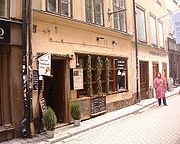
Tyska Brinken-Järntorget

Swedish House of Knights
The Swedish House of Nobility maintains records and acts as an interest group on behalf of the Swedish nobility.-Name:The name means either the corporation of the Swedish nobility or the palace of the nobility....
, following a common practice for burghers to copy decorations found on prominent palaces.
The current building on Number 54 was, according to an inscription on the portal, completed in 1662, but parts of the building are considerably older, the first owner, a Diedrik Skekerman from Lübeck
Lübeck
The Hanseatic City of Lübeck is the second-largest city in Schleswig-Holstein, in northern Germany, and one of the major ports of Germany. It was for several centuries the "capital" of the Hanseatic League and, because of its Brick Gothic architectural heritage, is listed by UNESCO as a World...
, appearing in historical records as a lodger and inkeeper in 1589-1597. The portal is made of red limestone and possibly designed by Nicodemus Tessin the Elder
Nicodemus Tessin the Elder
Nicodemus Tessin the Elder was an important Swedish architect.-Biography:Nicodemus Tessin was born in Stralsund in Pomerania and came to Sweden as a young man. There he met and worked with the architect Simon de la Vallée...
. In the basement of the building, five metres under street level, a sealed round arched tunnel have been found, thought to have led under Västerlånggatan to Prästgatan
Prästgatan
Prästgatan is a street in Gamla stan, the old town in central Stockholm, Sweden, stretching from a cul-de-sac west of the Royal Palace to the street Österlånggatan in the southern corner of the old town. Prästgatan forms a parallel street to Västerlånggatan, Trångsund, Skomakargatan, and...
and to have been built as an escape route in case the Danes would take the city. One of the oldest second-hand bookshops in Sweden, Aspingtons Antikvariat, was located here 1978-2001. The building is today owned by the trade union for the employees of the Customs and Coastguard (Tull-Kust).
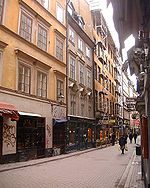
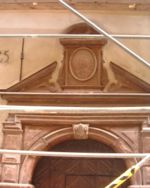
Cartouche
In Egyptian hieroglyphs, a cartouche is an ellipse with a horizontal line at one end, indicating that the text enclosed is a royal name, coming into use during the beginning of the Fourth Dynasty under Pharaoh Sneferu, replacing the earlier serekh...
of the portal of Number 65 is a Christogram
Christogram
A Christogram is a monogram or combination of letters that forms an abbreviation for the name of Jesus Christ, traditionally used as a Christian symbol. Different types of Christograms are associated with the various traditions of Christianity, e.g...
, IHS
IHS
IHS may refer to:* A common Christogram based on the first three letters of "Jesus" in Greek .* Abbreviation for the In hoc signo vinces legend.* IBM HTTP Server...
, the maxim SOLI DEI GLORIA ("To God alone the glory"), and the initials of the Holstein
Holstein
Holstein is the region between the rivers Elbe and Eider. It is part of Schleswig-Holstein, the northernmost state of Germany....
cloth trader Peter Hanssen and his wife Anna Steker:
| P | H |
| A | H |
| S | |
The couple, which restored the building during the 1660s, were very rich and, among other things, donated the pulpit still found in the German Church.
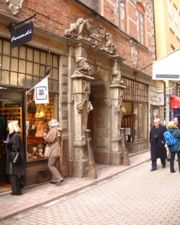
Gustavus Adolphus of Sweden
Gustav II Adolf has been widely known in English by his Latinized name Gustavus Adolphus Magnus and variously in historical writings also as Gustavus, or Gustavus the Great, or Gustav Adolph the Great,...
, was eventually raised to peerage under the name von der Linde. The bared brick wall of the Dutch Renaissance façade is richly decorated with sandstone ornaments cut by Aris Claeszon from Haarlem
Haarlem
Haarlem is a municipality and a city in the Netherlands. It is the capital of the province of North Holland, the northern half of Holland, which at one time was the most powerful of the seven provinces of the Dutch Republic...
, including the sumptuous portal. The two heads in the portico symbolizes Mercury
Mercury (mythology)
Mercury was a messenger who wore winged sandals, and a god of trade, the son of Maia Maiestas and Jupiter in Roman mythology. His name is related to the Latin word merx , mercari , and merces...
and Neptune
Neptune (mythology)
Neptune was the god of water and the sea in Roman mythology and religion. He is analogous with, but not identical to, the Greek god Poseidon. In the Greek-influenced tradition, Neptune was the brother of Jupiter and Pluto, each of them presiding over one of the three realms of the universe,...
and in the arms of Erik Larsson are two linden
Tilia cordata
Tilia cordata is a species of Tilia native to much of Europe and western Asia, north to southern Great Britain , central Scandinavia, east to central Russia, and south to central Spain, Italy, Bulgaria, Turkey, and the Caucasus; in the south of its range it is restricted to...
which he planted on his homestead at Lovön
Lovön
Lovön is an island located in the Swedish Lake Mälaren in Ekerö Municipality of Stockholm County. It was a municipality of its own until 1952, when it was joined with Ekerö Municipality. Lovön's greatest attraction is Drottningholm Palace and its many public gardens, which were built on the island...
. Flanking the portal are two cartouche
Cartouche
In Egyptian hieroglyphs, a cartouche is an ellipse with a horizontal line at one end, indicating that the text enclosed is a royal name, coming into use during the beginning of the Fourth Dynasty under Pharaoh Sneferu, replacing the earlier serekh...
s displaying inscriptions in German:
| AVF• / GOTT•AL / LEIN• / SETZ•DIE / HOFNVNG / DEIN |
| To god alone put the hope of yours. |
| AN / GOTTES / SEGEN / IST• / ALLES / GELEGEN |
| On God's blessing is all depending |
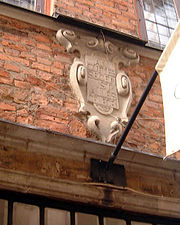
Christina of Sweden
Christina , later adopted the name Christina Alexandra, was Queen regnant of Swedes, Goths and Vandals, Grand Princess of Finland, and Duchess of Ingria, Estonia, Livonia and Karelia, from 1633 to 1654. She was the only surviving legitimate child of King Gustav II Adolph and his wife Maria Eleonora...
to her half-brother, Gustav, Count of Vasaborg
Gustav, Count of Vasaborg
Count Gustav Gustavsson af Vasaborg, 1st Count of Nystad was an illegitimate son of King Gustavus Adolphus and his mistress Margareta Slots. -Biography:...
, the illegitimate child of Gustavus Adolphus, who had a wing added facing the square on opposite side of block. The names of all proprietors, historical and present, are engraved on a slate behind the front door, a list ending with the Masonry Master's Guild (Murmestare Embetet i Stockholm), founded in the old town in 1487, and today using the building for their extensive archive. Two of the old proprietors have given their names to establishment residing in the building; the former confectioner Drottning Kristina facing the street and the banqueting rooms von der Lindeska valven in the basement

Funckens Gränd
Funckens Gränd is an alley in Gamla stan, the old town in central Stockholm, Sweden. Leading south from the street Västerlånggatan to the square Kornhamnstorg, it forms a parallel street to Torgdragargränd and Triewaldsgränd....
are the initials of former owners: L L D L 1627, Lydert Lang and Dorotea Lang. The present building on Number 72-74 is a product of the merging of two older buildings during the 20th century. In medieval times, these two buildings were separated by an alley of which remains a narrow and elongated backyard passing through the block. Various properties in the block have been merged and partitioned repeatedly over several centuries, and though virtually all traces of the medieval neighbourhood are gone, the present façade is decorated with bits and pieces of older buildings; placed in niches in the 1930s when the present shop front was built. The trader Thomas Funck owned most of the buildings in the neighbourhood in the 17th century, why he gave the alley its name. Number 76, mentioned together with the property on the opposite side of the block as "both buildings of late Funck", probably referring to one of the sons of the former. A medieval alley once passed through the building on Number 78, and the present building is partly from the early 17th century, while the shop windows and the attic were rebuilt in the 20th century.
On Number 79 is the restaurant Mårten Trotzig, named after Mårten Trotzigs Gränd
Mårten Trotzigs Gränd
Mårten Trotzigs gränd is an alley in Gamla stan, the old town of Stockholm, Sweden. Leading from Västerlånggatan and Järntorget up to Prästgatan and Tyska Stallplan, the width of its 36 steps tapers down to a mere 90 cm, making the alley the narrowest street in Stockholm.The alley is named...
, the narrowest alley in the old town passing next to it, in its turn named after the merchant Mårten Trotzig (1559-1617) who owned a building in the alley. In the restaurant is an excavated medieval refuse chute once accessed through an exterior door.
The Danish King Christian II
Christian II of Denmark
Christian II was King of Denmark, Norway and Sweden , during the Kalmar Union.-Background:...
entered Stockholm on September 7, 1520, following the surrender of Christina Gyllenstierna
Christina Gyllenstierna
Christina Nilsdotter of Fogelvik, Heiress of Tullgarn , was the wife of the Swedish regent Sten Sture the Younger, and after his death, leader of resistance to Christian II of Denmark...
, the widow queen of Sten Sture the Younger
Sten Sture the Younger
Sten Sture the Younger , Lord of Ekesiö , was a Swedish statesman and regent of Sweden, under the era of the Kalmar Union.-Life:...
, and became king of Sweden on November 1, as such he choose not to occupy the Royal Palace
Stockholm Palace
The Stockholm Palace is the official residence and major royal palace of the Swedish monarch. . Stockholm Palace is located on Stadsholmen , in Gamla Stan in the capital, Stockholm...
, but to stay with the German merchant Gorius Holst who lived in this building during the week preceding the Stockholm Bloodbath
Stockholm Bloodbath
The Stockholm Bloodbath, or the Stockholm Massacre , took place as the result of a successful invasion of Sweden by Danish forces under the command of King Christian II...
.
Much of the present block was created by the secretary of King Eric XIV
Eric XIV of Sweden
-Family and descendants:Eric XIV had several relationships before his marriage. With Agda Persdotter he had four daughters:#Margareta Eriksdotter , married 1592 to Olov Simonsson, vicar of Horn....
, Erik Göransson Tegel, who married Margareta Dantzeville, the widow of Reinhold Leuhusen who owned a building here. Tegel, mostly remembered for having written history books but who had more than one string to his bow and also worked as a spy in Denmark and Poland, started to buy neighbouring properties in order to enlarge his home, which gave the entire block a common history. An archaeological excavation in 1992 unveiled a wall and a vault in the backyard of the block. The painter Carl Larsson
Carl Larsson
Carl Larsson was a Swedish painter and interior designer, representative of the Arts and Crafts Movement. His many paintings include oils, watercolors, and frescoes...
was born here in 1853. While he today cherished for his watercolours of bright and colourful idyllic family sceneries, his gloomy childhood in the old town, caused him to live his life with melancholy constantly at hand.
The numbers of Västerlånggatan are continuous with those of Järntorget, so the addresses on the square are numbered 81-85 on the north side, and 78-84 on the southern.

